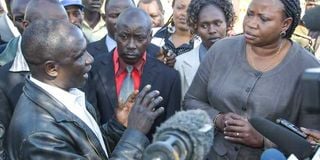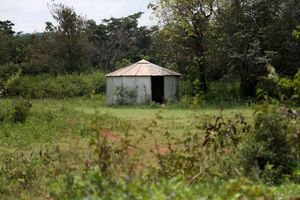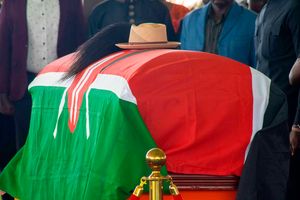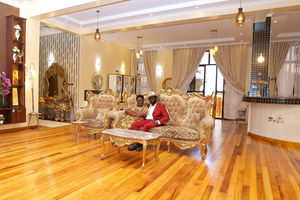Premium
What six ‘bribed’ witnesses held against Ruto during the ICC trial

ICC chief prosecutor Fatou Bensouda meets victims of the 2007/8 post-election violence in 2012. The ICC accused Mr Paul Mucheru of bribing and intimidating witnesses.
What you need to know:
- One of the key witnesses testified about the purchase of guns.
- Another described constant text messages purportedly sent to coordinate attacks.
The six witnesses Mr Paul Gicheru is accused of bribing to compromise the International Criminal Court (ICC) trial of Deputy President William Ruto and Mr Joshua arap Sang were central to the case but judges disregarded their testimony when their credibility became questionable.
Records released by The Hague-based court show that one of the key witnesses testified about the purchase of guns, another described constant text messages purportedly sent to coordinate attacks while another revealed training of militia to carry out attacks – claims the prosecution was banking on to support the existence of an organised criminal network, to which Dr Ruto and Mr Sang either belonged or had knowledge of.
The lawyer surrendered to Dutch authorities on Monday and was to be transferred to The Hague to be charged with corruptly influencing witnesses P-397, P-516, P-613, P-800, P-495 and P-536, during the trial that aborted in 2014.
P-397, whom prosecution says was given Sh1 million by Mr Gicheru in 2013 to renounce initial statements, later expressed willingness to cooperate with the prosecution but the court was told that the witness had been “abducted”.
The prosecution petitioned the judges to allow information relating to the witness, who prosecutors said had admitted to being bribed, to be withheld from the defence “until their security and attendance are ensured”.
“The timing of the occurrence of the ‘abduction’, shortly after the witness resumed contact with the prosecution, is consistent with the prosecution’s suggestion that the witness may be detained by persons who may wish him harm. It is conceivable in the circumstances that the alleged abduction relates to his cooperation with the prosecution,” the judges ruled on April 16 2014, when they authorised the prosecution to withhold the material from the defence until the witness’ security situation was addressed.
However, Justices Chile Eboe-Osuji, Olga Herrera Carbuccia and Robert Fremr rejected the prosecution’s claim that the witness had been abducted by persons associated (directly or indirectly) with Dr Ruto.
“This additional allegation was not supported by the material provided,” they said.
Improbable testimony
At the close of the prosecution’s case in 2016, the judges flagged the improbable testimony of witness 356 who claimed to have been detailed to look for guns that were to be used in attacks following the December 2017 presidential election.
“There is no obvious reason the core network members, and specifically Ruto, would turn to witness 356, who according to his own testimony worked as a tractor driver in a village, to obtain firearms, and the witness himself has not provided any explanation in this regard,” Justice Robert Fremr said on April 5, 2016, in the verdict that the pair had no case to answer.
This is the only witness who had remained after prior recorded testimony of hostile witnesses had been thrown out and the verdict crushed what the prosecution had provided as “the most incriminating evidence in relation to the acquisition of firearms by the Network”.
Prosecutors had relied on the testimony of witnesses P-516, P-800 and P-495 to prove claims of a criminal network that organised training of youths, but the rejection of their testimony weakened the case.
“The prosecution alleges that network members organised, financed and completed the training of youths to carry out attacks against Party of National Unity (PNU) supporters in order to drive them out of the Rift Valley. The prosecution relied on the evidence of witnesses 516, 800 and 495,” court papers read.
“As a result of the Appeals Chamber’s ruling, the prior-recorded statements of...witnesses 516 and 495 can no longer support the allegations,” Justice Fremr said.
Witnesses 800 and 495 worked for the same organisation that compiled evidence of the post-election violence, presumably an NGO.
The defence team had fought the prosecution’s push to be allowed to present statements recorded during preliminary investigations before the witnesses presumably turned hostile.
With the evidence of these two unavailable, the prosecution clutched on the last straw – the testimony of P-800, “the only remaining evidence relied on by the prosecution as proof that the training of youths took place”.
P-800 said he witnessed first-hand, from his home, youths leaving in lorries. He even claimed to have spoken to some who he said provided him with details of the three-week training camp at a farm in Boronjo, Uasin Gishu county.
But this testimony was shredded during cross-examination when the witness confirmed that he received the information about the training from his colleague at their workplace, P-495.
“Witness 800 confirmed that the information had been contained in a report that Witness 495 had prepared for an organisation that both these witnesses worked for at the time,” the judge said, noting that witness 495 had recanted his entire prior-recorded statement at trial and denied knowledge of any training of youths.
Personal gain
The credibility of the witness took a further hit when the judge said he had demonstrated “a willingness to lie in return for personal gain and induce others to lie as well, apparently without concern for the significant implications of such dishonesty”.
“In light of the Appeals Chamber’s decision related to Witnesses 516 and 495 and my assessment of the evidence given by Witness 800...the conclusion must be that the prosecution has not presented evidence upon which a reasonable trial chamber could find that youths were trained in anticipation of the violence,” the judge said.
The third pillar of the case that crumbled was the testimony by a woman on which stood the prosecution’s allegation that the network established and utilised a communications system through which Dr Ruto and others directed and received reports from direct perpetrators carrying out the attacks.
This was witness 613 who testified about a conversation she had with an acquaintance, a youth, who participated in an attack on Turbo town in January 2008.
“This person told her that Christopher Kisorio, Solomon Tirop and Farouk Kibet were in charge and were receiving directions from Ruto. The witness understood that these directions were sent in text messages. Her acquaintance, who reported to Tirop, had told her that Ruto would send Tirop messages containing messages such as ‘where are they’, and ‘how far have they gone,’” court papers state.
“Similarly, witness 613 assumed that the directions Ruto was allegedly giving to Kisorio, Tirop and Kibet were to be passed on to the youths, but did not explain the basis for this assumption. It is therefore noted that witness 613’s testimony as to the meaning of the text messages and the fact that they were passed on to youths is mere speculation,” Justice Fremr said.
“The witness did not see the content of the messages, but her knowledge of the words used is based on hearsay. Besides it not having been shown that the messages were being sent during or shortly before the attacks, I note that Witness 613’s testimony is, for example, the only piece of evidence for the allegations that ‘Mr Ruto was receiving reports on the progress of the attacks on Turbo directly from someone actually participating in the violence.’”





